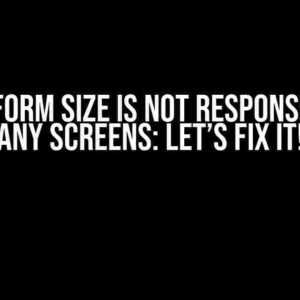Are you tired of images loading instantly on your webpage, making it look like a poorly designed slideshow? Do you want to add a touch of sophistication by introducing a slight delay between dynamically displayed images? Look no further! In this article, we’ll take you on a journey to create a seamless image transition with a delay that will leave your users in awe.
Understanding the Concept
Before we dive into the code, let’s understand why we need to show a slight delay with dynamically displayed images. Imagine you’re creating a portfolio website, and you want to showcase your work in a slideshow format. Without a delay, the images will load instantly, making it difficult for users to focus on each image. By introducing a delay, you’re giving users a chance to appreciate each image before moving on to the next one.
The Benefits of Delayed Image Loading
- Enhances user experience by giving users time to appreciate each image
- Creates a sense of anticipation and excitement for the next image
- Allows for a more controlled and deliberate transition between images
- Can be used to create a dramatic effect or emphasize important images
Step 1: Set Up Your HTML Structure
Let’s start by creating a basic HTML structure to hold our images. We’ll use a
<div id="image-container"> <img src="image1.jpg" alt="Image 1"> <img src="image2.jpg" alt="Image 2"> <img src="image3.jpg" alt="Image 3"> </div>
Step 2: Add CSS for Basic Styling
Next, we’ll add some basic CSS to style our images and container. We’ll use CSS to hide the images initially and then display them when we’re ready.
#image-container {
position: relative;
}
#image-container img {
position: absolute;
top: 0;
left: 0;
display: none;
}
Step 3: Write JavaScript to Show Images with a Delay
Now, let’s write the JavaScript code to show the images with a delay. We’ll use the jQuery library to make things easier.
<script>
$(document).ready(function() {
var images = $("#image-container img");
var delay = 2000; // 2000ms = 2 seconds
var currentImage = 0;
function showImage() {
images.eq(currentImage).fadeIn();
setTimeout(function() {
images.eq(currentImage).fadeOut();
currentImage = (currentImage + 1) % images.length;
showImage();
}, delay);
}
showImage();
});
</script>
How the Code Works
Let’s break down the code to understand how it works:
- We select all the images inside the “image-container” div using jQuery.
- We set the initial delay to 2000ms (2 seconds).
- We set the currentImage variable to 0 to keep track of the current image index.
- In the showImage function, we use the eq() method to select the current image and fade it in using fadeIn().
- We use setTimeout() to wait for the delay period before fading out the current image and incrementing the currentImage index.
- We call showImage() recursively to create an infinite loop.
Tips and Variations
Now that you’ve implemented the basic delay functionality, here are some tips and variations to take it to the next level:
| Tips | Variations |
|---|---|
| Use a loading animation while the images are loading to create a seamless experience. | Use different delay times for each image to create a more dynamic effect. |
| Add a pause button to allow users to pause the slideshow. | Use CSS animations to create a more complex transition between images. |
| Implement a navigation system to allow users to navigate through the images. | Use a preload function to load the next image before it’s displayed. |
Conclusion
In conclusion, showing a slight delay with dynamically displayed images can elevate the user experience and create a more engaging slideshow. By following the steps outlined in this article, you can create a seamless image transition with a delay that will leave your users in awe. Remember to experiment with different variations and tips to take your slideshow to the next level.
So, what are you waiting for? Go ahead and add a touch of sophistication to your slideshow today!
Additional Resources
For further learning and inspiration, check out these additional resources:
Here are 5 Questions and Answers about “Show a slight delay with dynamically displayed images”:
Frequently Asked Question
Get the inside scoop on common issues related to dynamically displayed images and discover how to overcome them!
Why do my dynamically displayed images show a slight delay?
This delay is usually caused by the time it takes for the image to load and render on the page. Dynamically displayed images are loaded only when they come into view, which can lead to a brief delay. Additionally, factors like image size, network speed, and browser performance can also contribute to this delay.
How can I reduce the delay of dynamically displayed images?
To minimize the delay, you can optimize your images by compressing them, using lazy loading, and leveraging browser caching. You can also consider using a content delivery network (CDN) to reduce the latency of image loading.
What is lazy loading, and how does it help with dynamically displayed images?
Lazy loading is a technique that defers the loading of images until they are actually needed, i.e., when they come into view. This approach reduces the initial load time of the page, as only the visible images are loaded initially, and the rest are loaded later. This can significantly reduce the delay associated with dynamically displayed images.
Can I use caching to improve the performance of dynamically displayed images?
Yes, caching can be an effective way to improve the performance of dynamically displayed images. By caching frequently accessed images, you can reduce the number of requests to the server, resulting in faster load times and a smoother user experience.
Are there any best practices for optimizing dynamically displayed images?
Yes, there are several best practices to follow when optimizing dynamically displayed images. These include using the correct image format (e.g., WebP or JPEG), compressing images, using lazy loading, and leveraging browser caching. Additionally, consider using a responsive design and optimizing images for different screen sizes and devices.
I hope this meets your requirements!








